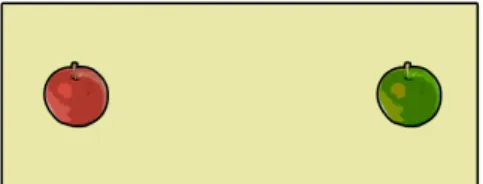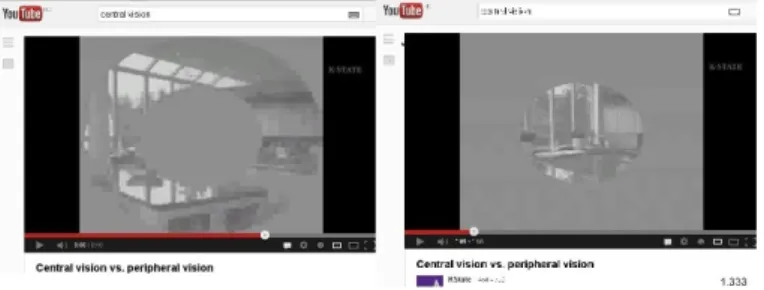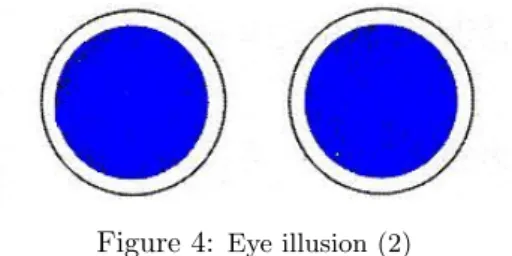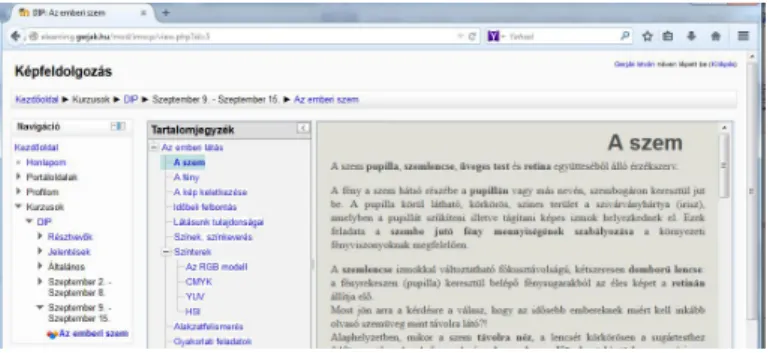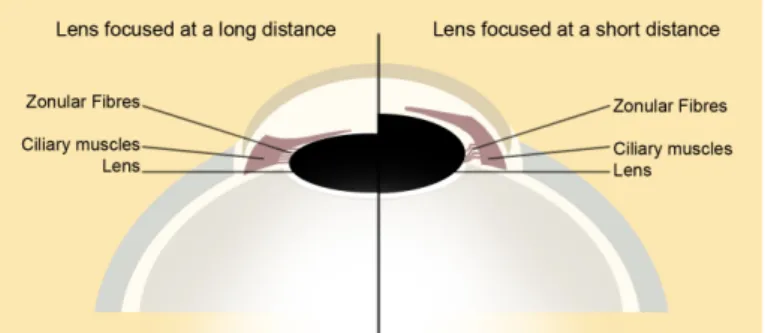Teaching digital image processing – eyes and eyesight
István Gerják
Óbuda University gerjakist@gmail.com
Submitted April 30, 2016 — Accepted November 12, 2017
Abstract
The necessity of digital image processing and its teaching have risen dra- matically in the past few years. Besides the appearance of digital cameras, the general use of smart phones suitable for making photos made it possible for anybody any time to take snapshots of the important events of their lives.
Through social community networks (for example Twitter or Facebook) we can share our photos with our friends and acquaintances.
The Internet craze makes computers attractive for youngsters and we have to reconsider some different forms of education in the world of emails and chatting radically. It refers to the fact that better and better digital teaching materials and their e-Book counterparts appear in increasing numbers. They try to surpass the traditional curriculum and get young people to study in this way as well.
In the present paper, which is part of a forthcoming series of articles we are looking for novel ways and opportunities of teaching digital image processing in secondary schools in this spirit and presenting the first chapter of the digital learning material developed by ourselves.
Keywords: Teaching digital image processing, seeing, functioning of human eyes, visual defects and their correction
MSC:68U10
1. Introduction
Infocommunication technologies (ICT) and digital competency play a key role in teaching in secondary schools [17]. Teachers who graduated more than 10 years
http://ami.uni-eszterhazy.hu
229
ago at universities did not learn, moreover, were not able to learn the latest mod- ern Internet or mobile technologies. The knowledge they should obtain could be accessed by taking part in courses or asking their IT teacher colleagues if they had enough time for this.
In our articles, which review the chapters of our coursebook separately we want to shed light on how important the computer, information technologies and the multimedia in education are and would like to publish contents and methods that illustrate the potential possibilities of this novel type of educational environment.
Also, we want to represent the connection between our curriculum and NAT ob- jectives in which they have declared that the acquired knowledge must be durable, and it must meet the demands of our age. Our curriculum also fits into the idea that a common educational material must be available for everyone.[18]
Hereinafter we are also dealing with what and how we should teach about digital image processing at secondary schools and how our digital material supports teaching original thinking [19]. Our material assists teaching how to study as students while applying it can organise their own studies either individually or in groups, they learn to be able to manage time and information [20][21] When applying our material students can get to know how the media work and make their influence felt [20].
We are using a Moodle framework, which helps students put forth their in- dividual abilities and talents so assists their applying controlling and assessing procedures [22].
According to NAT experimentation, observation, and the differentiated develop- ment of natural scientific thinking are particularly important. NAT also considers important that the teachers of different subjects should help each other to make students’ knowledge complete and interesting.
In our material, the first chapter deals with the eye and eyesight, which is the main topic our present paper, we kept these two objectives in view[23].
No books are available for teaching Digital Image Processing in secondary schools they would be necessary though. This is the reason why we have developed our website (www.gerjak.hu). The first chapter in this material is about eyes and sight which is the main theme of this article. Since our paper mainly focuses on secondary school students, our references come mostly from popular books instead of scientific papers, which are difficult for them to understand.
Students could learn about eyes and eyesight in four subjects. Under the study of biology course there is only one page about the structure and the diseases of eyes (strabismus, cataracts, nearsightedness, and farsightedness [6]. Physics deals with the eyepiece, the myopic and hyperopic eyes on half a page [9].
Drawing and visual culture do not teach about the eye [1]. Besides, the creation of multimedia contents and web pages also require getting to know how the eyes function and it is necessary to know where and in what colour the contents, which are important for us should be placed. Therefore, the main questions about eyes and eyesight could be taught in informatics lessons as well.
As these days this topic has not been developed properly in textbooks, it leads
to the task: let’s work it out. In Chapter 2 of this paper after the introduction, we discuss the material that can be found on our website and which includes the knowledge students need to learn to perform the practices described in Chapter 2.
Chapter 4 is about the development and the protection of the eyes and repairing visual errors.
1.1. Teaching digital image processing
Why is our curriculum necessary and what should it be about? What we need to learn and what we need largely depends on our profession and the life we choose.
Earlier books were published by printers and they learned the craft of printing, the colours, the fonts, the properties of light, and their ‘treatment’.
Today, everyone documents his own life (portfolio, website) and everyone is a printer as well. They need to learn the rules of visualisation so they also need to know the rules of ‘eyesight’. Doctors study different things about eyes, painters need to see other things than turners, physicist, and IT specialists. We should teach complex skills together with other scientific fields.
Our curriculum enhances the teaching of Digital Image Processing. Our choice is supported not only by the complexity and timeliness of the topic and the need for practical skills on the subject but it is fully in line with the following statements of Comenius [8]: “Everything must be placed before the senses. Everything visible should be brought before the organ of sight, everything audible before that of hear- ing. Odours should be placed before the sense of smell, and things that are testable and tangible before the sense of taste and of touch respectively. If something can be sensed with more than one organ, it should be placed before each organ.”
When and where should knowledge on Digital Image Processing be taught?
According to the international and domestic trends word processing and spread- sheets should not be taught in IT lessons for students, but in the linguistic and mathematical training courses [15].
Instead of them, extensive use of ICT tools for teaching digital image processing techniques should be taught. The topics in relation to this could be the follow- ing: the proper use of human eyes (‘proper’ eyesight, usage of colours, prevention of eye diseases and eye fatigue, photography, scanning techniques, compression, filtering, improvement of photos, animation- and film-making (e.g. cutting details from existing films), converting audio and image files and presentation of web-based materials.
Accordingly, the main chapters of our curriculum are the following:
• Human vision
• Human vision / Interpretation
• Digitalization
• Photography
• Light / colours
• Image processing skills
• Creation of multimedia files / Conversion
• Creation of movies / Uploading them on websites
In our opinion, the number of lessons for teaching them is enough but there is neither curriculum nor textbook for teaching them. Skimming through the websites of secondary schools and their curriculum of informatics we can see that mostly only the creation of presentation is taught except for schools where students are taught image processing by using GIMP and creating websites only as much as it is necessary for the final exam requirements.
Most of our colleagues believe and surveys also show that the lessons given are not enough to practice and solve problems. The new tools could ease this difficulty. Using digital and e-learning materials through the Internet students could practice enough and these materials could arouse their interest more than traditional exercise books.
Besides, ICT devices maintain the students’ curiosity and ongoing activity and the use of constructive teaching methods. During the creation of our curriculum we paid attention to the results of modern brain research of Josef Kraus who defined the following principles for teaching [16]:
• teaching must be activating
• The teaching-learning process must be multi-channel
• More relaxed and restful phases must be ensured
• There is a need to use surprising and unexpected situations to provoke the students’ attention
But why should we study the human eye and eyesight first?
Man has always grabbed beautiful, colourful or spectacular things. Design elements are always better stuck in his memory. Although there has been no scientific research about it, almost all books, which deal with this topic mention that the efficiency of getting information by reading, hearing and seeing parallel is much better and the efficiency of seeing is two or three times better than the efficiency of the other senses [12, 5].
Why do pictures, moving figures, animations, flashes and films have such great influence on us? We will give an answer to this question at the end of our articles as well.
In earlier years teachers did their experiments with real appliances in their laboratories of physics or chemistry. All our senses played an important part in receiving and understanding information during those experiments. We touched, smelled, tasted and looked at the objects. Nowadays, in a computerized, virtual world teaching is done almost exclusively through the monitor or the projector, so the role of sight has become much more important in receiving information. That is why this paper gives such a detailed description of the parts of the eye and shows their interesting and humorous presentation during lessons.
Nowadays, besides learning everything appeals to the eye-marketing, commer- cials and food. So it is essential that both as a creator and a recipient we should be aware of all the impulses that affect the eye. Unfortunately this new ’seeing’
and the overstrain of the eye have led to more and more eye diseases. That is why at the end of this paper we are drawing attention to the health hazards of work on the computer.
We should start teaching the causes of eye fatigue and lachrymation and also finding a solution to them at secondary schools.
It is difficult to write about everything on this topic in one paper, so those interested can read further useful tips that have been left out in our next articles.
In this paper we review the first chapter (Human sight) from our developed curriculum. In our forthcoming paper we will deal with the second chapter (Hu- man sight/interpretation) and the Moodle-material and we are planning to publish further chapters as well.
2. The eye and eyesight
Teaching is not about ‘frontal’ lessons any more. Plenty of curriculum and video can be found on the Internet. Our task is to guide our students along the ‘right’
route. This is the route we follow while getting to know the eye. We intend three lessons for this topic. During the first lesson we talk about the eye as ‘technical’
means.
We throw light on new notions connected to the functioning of the eye then the teacher calls the students’ attention to websites on the topic and finally we put it all to practice in the course of project work. At the end of the lesson we talk about the experience we gained during the lesson, then in the final five minutes we do exercises related to the eye. The necessity and types of these exercises are dealt with in Chapter 4.
In the next lesson the students give account of the results of their search on the Internet, which will be discussed together, then we will deal with signals coming from the eye to the brain, that is sight. Having talked over the related notions, the course of this lesson is the same as that of the previous lesson. We finish the topic in the third lesson.
Why should we start our curriculum with the eye?
The knowledge of multiplication table is indispensable in mathematics as well.
To know the eye is also important, as 80% of our knowledge comes to us through it. It is important to know the size, and the colour of the eye and also what colour- environment information it sees ‘well’ and why. What calls our attention and what disturbs us? It is essential to be aware of central and peripheral sight as they are the basis of commercials put on the sides of websites and flashing notices.
2.1. The structure and funcioning of the eye
In the course of the lesson (we are following it in this paper) we give short pieces of knowledge, then we discuss the notions, which we want to find (key words), and finally we do exercises on the given topic. We can find some videos on the functions of the eye on YouTube, e.g.: http://youtube.com/watch?v=Sqr6LKIR2b8
The most perfect known organ of sight is the complex eye, which can recognise formations already. Homework: searching on the Internet – complex eye, types of eyes.
As teachers we should call our students’ attention to some websites, which were created for educational purposes.
Prompt: https://hu.wikipedia.org/wiki/Szem,www.gerjak.hu
Figure 1: Experiment to prove the existence of the macula cocea
The eyes of vertebrates contain a blind spot, which can have advantages and disadvantages as well.
Homework. Searching on the internet – blind spot, left and right cerebral hemispheres, 3Dsight
Exercise. When we move closer to the red apple (left), the green apple disap- pears. When we move even closer, the green apple appears again. We can do this experiment with the right eye as well (see Figure 1)
Our eyes, which have more or less spherical forms, are located in the eye-sockets and are protected by seven different bones. The eyelids protect our eyes from the outside world and light.
Homework. Search on the Internet-bones, eyelids
Exercise. We should press our closed eyelids with our nails
Effect. We can see light coming from the direction where light falls on the pressed place. This proves that senses are created in the brain and not in the sense organs.
We move our eyes up and down and sideways so that we can see our environment as widely as possible. These movements are made by three pairs of ocular muscles.
According to latest studies, visual defects can be cured with the help of ocular muscles [2, 3, 4, 25]. The deformation of the eyeball caused by old age can also be improved by ocular exercises.
Exercise. Ocular exercise –looking near and far with our eyes We can experi- ence the sizzling noise of the muscles of the eye.
Exercise. When we keep closing our eyes quickly and strongly, we can hear some kind of sizzling noise Prrrrrrrr when compressing our eyelids. This noise can be heard for some seconds then it stops. The reason is: the palpebral muscle and the stirrup muscle belong to the facial nerve (nervus facialis).
The following movements of the eye are performed motorized by the brain when we focus on an object with both eyes.
Exercise. We close one of our eyes and look at the object with the open eye.
We can feel the movement of the closed eye to the direction of the target object.
Another important movement of the eye is the saccadic following movement.
In this case, we change the peripheral vision (where there is poor vision) for the fovea (where there is sharp vision).
Exercise. Watching a video on central and peripheral sight Peripheral vision is quicker and it helps us recognise our environment. Central vision is used for recognising objects [6].
Figure 2: Comparing central and peripheral vision
Getting to know the eyeball, the iris, the cornea and the crystelline lens is also given as homework.
Exercise. Students can see the clearness of the vitreous humour individually when they lie on the grass in sunny weather and look at the blue sky, taking care that they do not look into the sun. They can see small, fluffy things floating, of which they might think that it is their aura, but it is only the clarification process of the vitreous humour.
The slit in the middle of the iris, the diameter of the iris is moved reflex-like, that is unintentionally by the ocular muscles according to the strength of light coming into the eye [10, 29]. It tightens in strong light and widens in dim light, thus regulating the quantity of light falling on the retina.
Exercise. The narrowing of the pupil can be examined carefully with the help of a torch. Approaching the eye with a torch and removing the torch result in the narrowing and the widening of the pupil. We have shown the movement of the pupil on our website (www.gerjak.hu).
We can perceive other people’s feelings and thoughts if we watch the widening of their pupils. Under the influence of joy, excitement or desire the pupil can widen even quadruple of its original state [11]. When we are angry or nervous, our eyes become piercing and our pupils become narrow.
Men and women can realise whether they are attractive to each other or not by watching each other’s pupils. Children also look at grown-ups with their eyes wide open, thus expressing their admiration. Making use of it, models of beauty products and fashion design clothes are taken photos with wider pupils so that the products they advertise could be sold more easily [26]. That is also the reason why card-gamers wear glasses. They do not want their wide pupils to reveal their lucky run of the cards.
The eye is the most significant means of communication because of its central place and also because it functions beyond our control, this way providing us with accurate information about the other person. The brain performs the widening of the pupil automatically and interprets it. We can examine it with Eckhard Hess’
pupil test [27].
When we have our students look at Figure 3 their pupils get constricted because their brains perceive it as if a pair of piercing eyes was looking at them.
Figure 3: Eye illusion
Then when looking at Figure 4, their pupils widen because they perceive it as if a pair of attractive eyes was looking at them.
Figure 4: Eye illusion (2)
Light stimulating nerve nuclei in the brainstem affect pupil constricting muscles.
Exercise. As nerve fibres cross each other, when we shine light into the right eye, the pupil of the left eye gets constricted as well.
The shape of the lens changes according to distance [5]. When we look at a shorter distance, the ciliary muscle contracts, so the suspensory ligaments of the lens loosen and the lens, as it is flexible, becomes more convex. When we look at a greater distance, the ciliary muscle loosens and the lens becomes flat due to the tightening of the ligaments.
Here is a good exercise to move and accommodate the crystalline lens. Hold your fingers at two cms from each other and look at your fingers first and then look through them and focus a bit farther. (About two-three cms) The so-called sausage-effect occurs when we see a sausage between our two fingertips [28]. The reason is: we can see with both of our eyes and as we focus at a greater distance, our brain cannot decide whether it can really see two fingers or whether it should erase one of them. The topic of visual illusions is so rich that it deserves a separate study.
The eye can be seen as an optical low pass. We can perceive changes only to some extent [30].
Exercise. This proves that cut-off frequency decreases with nictating and closing the eyes quickly. Then only dark and light spots remain identifiable (see Figure 5).
Figure 5: Sausage effect of the eye
3. New approach required in the teaching of sight
We perceive the world around us with our eyes and evaluate it with our brains.
Out of the sense organs the eye is the quickest provider of data transfer. It has the longest perceiving distance and the best adaptability. It is capable of adapting to different light conditions, cold and heat, dryness and wetness.
We have to be ‘wonderful’ and ‘interesting’ in teaching as well if we want to become acquainted with this wonder of our body in its true aspect. Fortunately there are all kinds of IT and communication devices and we can also use other people’s ideas, films and photos to expand our knowledge.
Students are susceptible to interesting things but then they are unable to listen attentively for a long time, so you have to arouse their interest again.
In secondary education it is very important that knowledge should be conveyed in a funny, entertaining way and possibly be accompanied by short animations and film projection.
After teaching our students the theory about the different parts of the eye during a lesson, we tried to attach some interesting stories or exercises to each part of our work on human eye to fix what we have learnt in the students’ memories.
Human brain can remember interesting and especially cathartic experiences much more easily.
Although in our next paper we will write in details about our tools, which assist teaching, we are presenting a Moodle screen picture from our material on the eye (see Figure 6).
4. Possible ways of the development of the eye
The development of our eyes has always been directed by evolution. It has devel- oped in a certain direction if was advantageous for the preservation of our race or selection. There are different phases of development to prove this.
Figure 6: Moodle website
Predatory animals and man have their eyes on the front because stereo sight helps to estimate distance and grab food. ‘Prey animals’ have their eyes on the sides of their heads, which enables them to see the world in 360 degrees, thus they can escape attacks coming from any direction [7]. Our eyes have only a 180 degree visual field but we can improve this by hunting in ‘hordes’. This is what most predatory animals also do.
Seeing colours also serves this development. First we had to distinguish only between blue and green colours so that we could perceive the sky and water and also because we had leaf-eating habits similarly to monkeys. Later on we had to be able to perceive red to find ripe fruit.
The camouflage of insects is impossible in three-dimensional space, so they have developed depth perception [14]. So we can say when necessity arises, our body satisfies all our needs. This has been mostly the case for a couple of millions of years. What about our eyes? Will working a lot on the computer turn them from 3D eyes into 2D ones? Will we have to look at the world around us through special glasses as in 3D movies and also with some equipment, which can see in the dark?
Will young people become more passive in their community contacts and way of thinking because they start to use the computer too early? When we read we can imagine what we have read about while TV and computers provide us with everything. Future will tell but we should take care of the wonderful abilities of our eyes, which also contribute to the fact that man could become the masterpiece of creation or from another point of view the ‘top predatory animal’ in the world.
4.1. Our actions, which endanger our sight, protection of the eye, eye-defects and the ways of curing them
In a German survey 70% of the people working on the computer complained that their eyes got tired very soon and 65% of them complained of light sensitivity. 55%
of the people asked had a stinging pain in their eyes. 32% of them complained about dry eyes and diminishing visual abilities. Almost 30% of them had moist eyes and a growing pressure in their eyes. 25% of them experienced red eyes [24].
We have no information about a similar survey in Hungary but teachers and students have the same complaints. What are these complaints caused by? Our eyes were made to see in 3D. Following movements, focusing, and accommodating, saccadic movement – all use certain parts of the eye and the body has prepared for them gradually of computers. Looking at the monitor fixedly, less nictating, steady focusing at 30-40 cms cause the tiredness of the ciliary muscles and the dryness of the eye.
Our eyes keep moving in their natural circumstances. During evolution hunting, searching for food and orientation required of our eyes to focus frequently at distant and close objects. We call it accommodation.
During work on the computer we look at a short distance permanently, thus our ciliary muscles are kept tensely for a long time, so they get tired. After work the lens often needs an hour to get back to normal. (When looking at short distances the ciliary muscles are tense, the zonular fibres are loose. When looking at long distances it is the other way round (see Figure 7).
Figure 7: Accommodation of the lens
Our eyes have to adapt to different light conditions, as in the open air sunshine and shade, dusk and darkness, open and close spaces alternate with each other.
Our eyes need to adapt to changes from dark to light and vice versa.
While working on the computer the amount of light, which falls into the eye changes constantly, light and dark surfaces alternate, so our eyes need constant adaptation, which is very tiring. Our eyes can be irritated by looking directly at the source of light or at a luminous surface.
We have to nictate 25-30 times a minute to clean and nourish our eyes. Thus our eyelids spread a layer of tears on our eyes. When we stare at the monitor permanently, we forget about nictating, so we do it only once or twice a minute.
This way our eyes get dry and it causes a burning, itchy feeling. So Japanese scientists produced a pair of glasses, which becomes dark after not nictating for a long time and it becomes clear after nictating, thus getting computer users to nictate [13].
During work on the computer we overburden our spine, so burdening the second cervical vertebra (which is related to the functioning of the eyes) does harm to our
sight as well. Sitting while working, pressing our stomach and staying almost motionless hinders the provision of our brains and sight with oxygen and blood.
As we have seen, working on the computer has an effect on the whole body.
According to Dr.Arnold Gesell, ‘The whole human body takes part in the process of sight’, so we have to cure the whole body to improve our sight [24].
We can find health sanitary courses in foreign countries like Japan and Germany, which improve the sight of those people who do computer work. There are no similar initiatives known in Hungary. We should teach secondary school children how to protect their eyes and bodies from the dangers of computer work.
In the last five minutes of our information technology lessons at school we have exercises, which improve the students’ eyesight and health.
There are three main areas of these exercises: practising eye movements (nic- tating), loosening muscles and soothing the nerval system.
Exercise 1. We look at a distant point with our eyes, then at out nose 10 times alternately
Exercise 2. neck-circle, then shoulder-circle 10 times
Exercise 3. In pairs we bend our backbones, one spondyle after the other forward, then back, while our pair carefully follows the movement on our spine with his/her hand.
5. Summary
In secondary school education we should make an effort to achieve that the material taught at different lessons should complement each other.
Our eyes are used in every lesson but their functioning is mentioned only in biology lessons, though very insufficiently and leaving out the functioning of the eye.The learning process takes place more and more with the help of the Internet, so we are supposed to adapt to this tendency. During lessons it is recommended to follow the order presented in this work. First we should tell our students to find information on the functioning of the eye and use the proper websites, including ours (see Chapter 2). Then as it is shown in Chapter 2, we should commit what we have taught in their memories through experiments.
In the next lesson we should revise everything that we have taught about the eye and ask our students if they can find a connection between work on the computer and the way we use our eyes (with special regard to what we have written in Chapter 4). We should try hard to get our students to notice any possible eye problems and the ways of prevention and cure.
This article has presented only tutorial topics and we have touched upon the methodology of teaching. We are planning to write about the results in our forth- coming articles.
We cannot talk about everything within the framework of one article. Our aim was to demonstrate that within the scope of digital image processing the topic of human eye and sight has provided us with means, which teachers would never have
dreamt of earlier. It is up to us to what extent and how much we can get our students involved and how to make use of it.
References
[1] A képzelet világa 1-2. Imrehné Sebestyén Margit. OM Kerettanterv 17/2004.(V.20.) Apáczai Kiadó., 2011.
[2] Balázs Rozália: Természetes nézés (Natural looking). 2015. Sites.google.comhttp://
sites.google.com/site/balazsrozalia/home/gygymdok-terpik/termszetes-nzs (letöltve:2015.05.25)
[3] Bates W. H.: Tökéletes látás szemüveg nélkül (Perfect vision without glasses).http:
//www.bates-osszes.hupont.hu/2/tokeletes-latas-szemuveg-nelkul (letöltés:
2015.05.25.)
[4] Benjamin Harry: Tökéletes látás szemüveg nélkül (Perfect vision without glasses).
Bioenergetic Kiadó Kft. 2012. ISBN 9789632911410
[5] Berke József, Hegedűs Gy.Gyula, Kelemen Dezső, Szabó József: Digitális képfeldol- gozás és alkalmazásai (Digital image processing and applications). LSI, 14–16.
[6] Biológia 10., Berger Józsefné. Prizma Könyvek. Nemzeti Tankönyvkiadó Zrt., 2006.
79–80.
[7] Blakemore, Gombrich, Gregory: Illúzió a természetben és a művészetben (Illusion in nature and art). Budapest. 11., 23., 24., 32., 45–46., 93. oldal
[8] Comenius, J. A.: A látható világ (Orbis pictus). Magyar Helikon Kk., 1959/ Az 1669-ben megjelent kiadás alapján.
[9] Fizika 10., Medgyes Sándorné. Prizma Könyvek. Nemzeti Tankönyvkiadó Zrt., 2006.
16. oldal
[10] Greenfield, S. A.: Utazás az agy körül (The Human Brain). VILÁG-EGYETEM, Kulturtrade Kiadó Kft., 1998. ISBN 963 9069 65 5. 104. oldal
[11] Greenfield, S. A.: Utazás az agy körül (The Human Brain). VILÁG-EGYETEM, Kulturtrade Kiadó Kft., 1998. ISBN 963 9069 65 5. 105. oldal
[12] Holzinger, Andreas: A multimédia alapjai (The basics of multimedia). Kiskapu Kft., 2004. ISBN 963 9301 71. 7. oldal
[13] hvg.hu/tudomany/20091027
[14] Julesz Béla: Dialógusok az észlelésről (Dialogues about perception). Typotex Kiadó, Budapest, 2000. 88. oldal
[15] Kiss Gábor: A Magyar és a nemzetközi informatikaoktatás összehasonlítása (Com- parison of Hungarian and International Informatics Education). PhD értekezés, De- breceni Egyetem, 2012. 15. oldal
[16] Kraus J. (Gordana Stankov: Konkrét és kepi reprezentációk használata a hetedik osz- tályos algebratanításban (CONCRETE AND IMAGE REPRESENTATIONS USE THE SECOND CLASS ALGEBRA IN TEACHING). PhD értekezés, Debreceni Egyetem, 2008. 6. oldal.
[17] NAT 2012.In: A Kormány 110/2012. (VI.4.) Korm. Rendelete a Nemzeti alaptanterv kiadásáról, bevezetéséről és alkalmazásáról,Magyar Közlöny 2012.66. sz. Page:10654- 10655.
[18] NAT 2012.In: A Kormány 110/2012. (VI.4.) Korm. Rendelete a Nemzeti alaptanterv kiadásáról, bevezetéséről és alkalmazásáról,Magyar Közlöny 2012.66. sz. Page:10640.
[19] NAT 2012.In: A Kormány 110/2012. (VI.4.) Korm. Rendelete a Nemzeti alaptanterv kiadásáról, bevezetéséről és alkalmazásáról,Magyar Közlöny 2012.66. sz. Page:10641.
[20] NAT 2012.In: A Kormány 110/2012. (VI.4.) Korm. Rendelete a Nemzeti alaptanterv kiadásáról, bevezetéséről és alkalmazásáról,Magyar Közlöny 2012.66. sz. Page:10644.
[21] NAT 2012.In: A Kormány 110/2012. (VI.4.) Korm. Rendelete a Nemzeti alaptanterv kiadásáról, bevezetéséről és alkalmazásáról,Magyar Közlöny 2012.66. sz. Page:10657.
[22] NAT 2012.In: A Kormány 110/2012. (VI.4.) Korm. Rendelete a Nemzeti alaptanterv kiadásáról, bevezetéséről és alkalmazásáról,Magyar Közlöny 2012.66. sz. Page:10645.
[23] NAT 2012.In: A Kormány 110/2012. (VI.4.) Korm. Rendelete a Nemzeti alaptanterv kiadásáról, bevezetéséről és alkalmazásáról,Magyar Közlöny 2012.66. sz. Page:10648- 10649.
[24] Ostermeier, Uschi-Sitkowski:Szemtorna a számítógépnél (Eyes exercise at the com- puter). M-érték Könyvkiadó Kft., Budapest, 2003.
[25] Ozsváth Mária dr.:Szemtréning 2015. http://www.alternativszemdr.hu/
indexphp?modul=szemtrening-iriszdiagnosztika(letöltés:2015.05.25)
[26] Pease, B. és A.: A testbeszéd enciklopédiája (The Definitive Book of Body Lan- guage). Park Könyvkiadó, Budapest 2008. 153. oldal
[27] Pease, B. és A.: A testbeszéd enciklopédiája (The Definitive Book of Body Lan- guage). Park Könyvkiadó, Budapest 2008. 155. oldal
[28] Reader’s Digest: A lélek és az értelem ABC-je (ABC of the soul and the mind).
London 1992 ISBN 963 8475 13 7.
[29] Smith, M.: Az emberi test (The Human Body). Szalay Könyvek. 33. oldal
[30] Steinmetz, R.: Multimédia (Multimedia). Springer Hungarica Kiadó Kft. Budapest, 1995. ISBN 963 8455 79 9. 55. oldal
